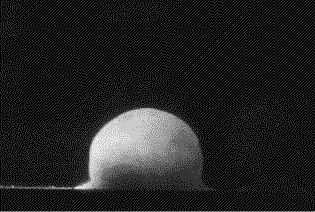|
It is human nature to want what another has, though usually it is wanted bigger
and better. Keeping up with the Jones’, right? During the technological revolution, that is exactly the feeling that the U.S.S.R. and the United
States possessed. When one nation announced
they owned a weapon so powerful that just one could decimate a country, the other just had to have one, as well as a means
to launch it. This constant attempt to be better than the other continued between
the Soviets and Americans until détente and the theory of mutually assured destruction, or MAD, were agreed upon in the ‘60’s and ‘70’s. These
theories ultimately kept the Cold War “cold”, with a lack of heated battles between the countries, because both
preferred keeping their country intact. But, in any case, the need to outdo the
other left the world with technology far better than anything they had ever known, and weapons that scared even the people
who created them.
The world realized the devastation
caused by nuclear warfare in 1945, when the United States dropped two nuclear
bombs, one on the city of Hiroshima and the other on Nagasaki. These bombings came after America
tested its first bomb in Los Alamos, and discovered the bomb’s destructive potential. Soon after, the Soviet Union tested their own nuclear
bomb, in 1949. This was not unexpected; however it was sooner than anticipated.
“The American intelligence community generally believed the Soviet Union would not have "the bomb" until 1952 or even
later, not August 1949” (“Nuclear Proliferation”). It is generally believed that the
Soviet Union was able to speed up its testing through its use of spies. The United States then
created the hydrogen bomb. The H-bomb, as it became known, was much smaller and
lighter. This allowed the bomb to travel longer distances than the nuclear bombs
that the U.S. had worked with before.
It also allowed for larger explosions, permitting more damage. In addition to
the weapons, the United States created
the means to transport and launch them. The most notable were the Polaris submarines
that made it possible to get close to the intended target country without being detected.
With so much power resting in America’s
hands, the world was on edge, waiting to see if this power would be exerted. (Simkin)
Of course, the Soviets did not want to be
left behind in this nuclear arms race for fear of being destroyed, so although lagging behind, the Soviets began attempting
to keep up with the United States. The Soviet Union started testing bombs in earnest.
They released a fission bomb in 1953 and created a thermonuclear explosion by 1955. (“Nuclear Proliferation”) By the early 1960’s, the Soviet Union had increased their stockpile of nuclear weapons to rival that of
the United States, but they were still
not to the quality of the Americans. The Soviets needed a new plan if they were
going to keep themselves from being destroyed. That is when they looked to Cuba. “On October 22, 1962, after reviewing newly acquired
intelligence, President John F. Kennedy informed the world that the Soviet Union was building secret missile bases in Cuba,
a mere 90 miles off the shores of Florida” (“The Cuban Missile Crisis”). The Soviets took a strategic move and placed themselves right off of the United States coast, right at its underbelly. With the attention they had so badly reached for in hand, the Soviets were finally even with U.S.
Because of the strategic places both countries had situated themselves in, they were at a stalemate. They were either going to have to call it quits or wait to see who would pull the
trigger first. The agreement they reached became known as the theory of mutually
assured destruction, or MAD, meaning if the U.S.S.R. “attacked the west, the west would make sure that they would suitably
retaliate i.e. there would be no winners” (“Nuclear Arms Race”). The two countries found common ground with this agreement, and although both
continued testing and stockpiling, the mutual agreement of not using them unless they cared to have one used on them lingered.
When the Soviet Union saw that the United States had weapons that could potentially be
used against them one day, they immediately started on their way to catching up. However,
once the two nations were on level playing ground, they realized that the MAD theory seemed rather appealing. Luckily for the world, the Soviets and the Americans chose to put their extra time and energy that they
were now not using in the Arms Race, into the Space Race.

|
| "The First .11 Seconds of the Nuclear Age" |
|

